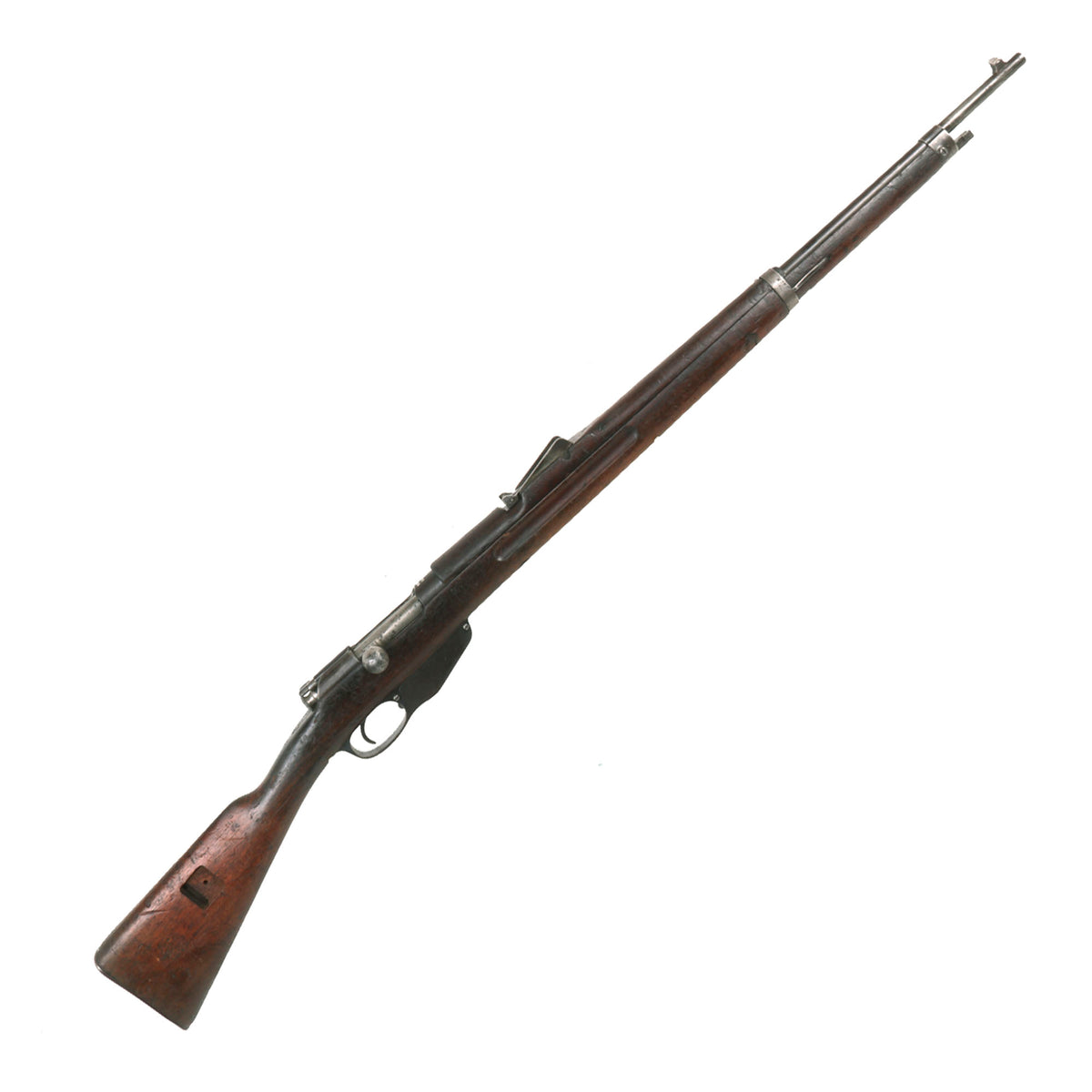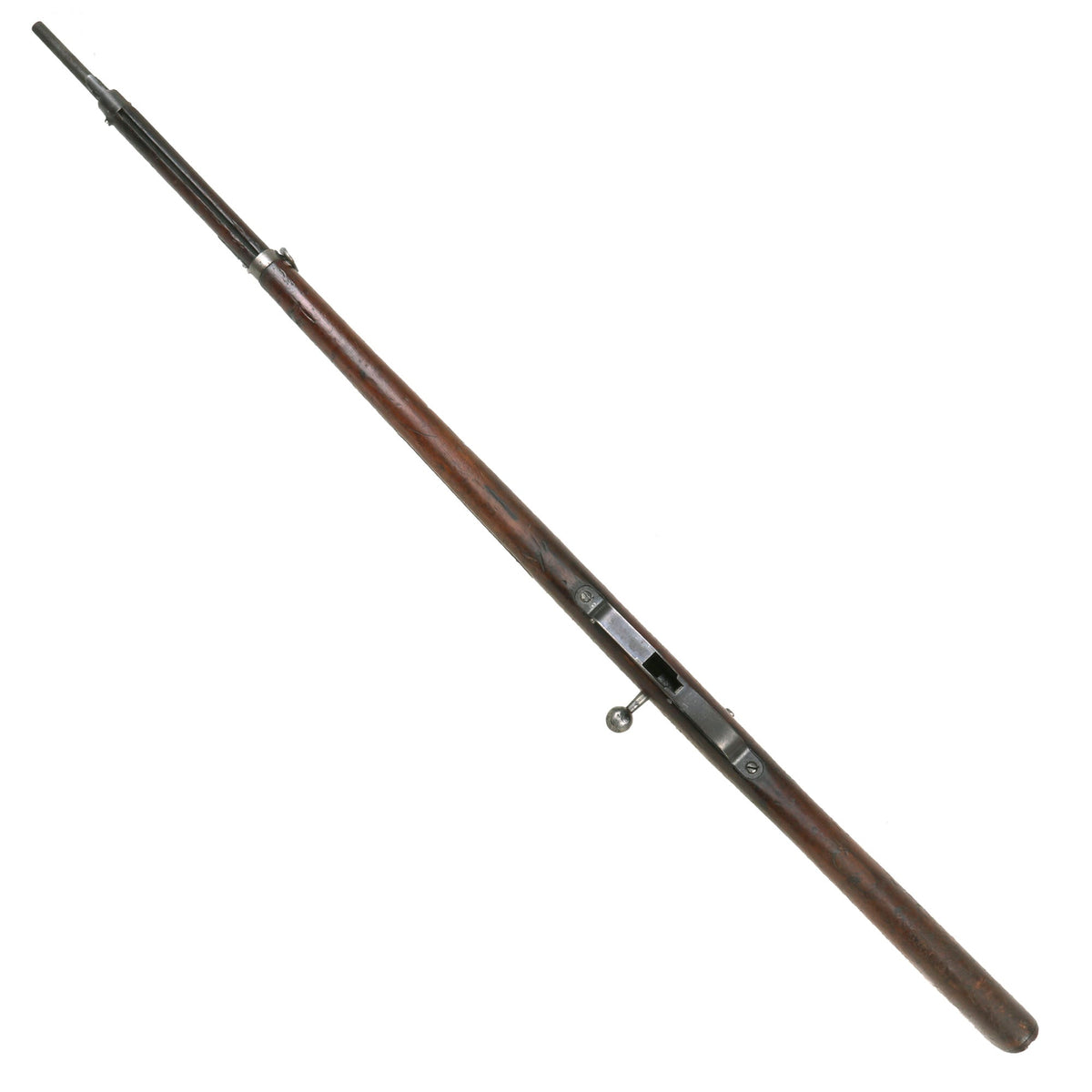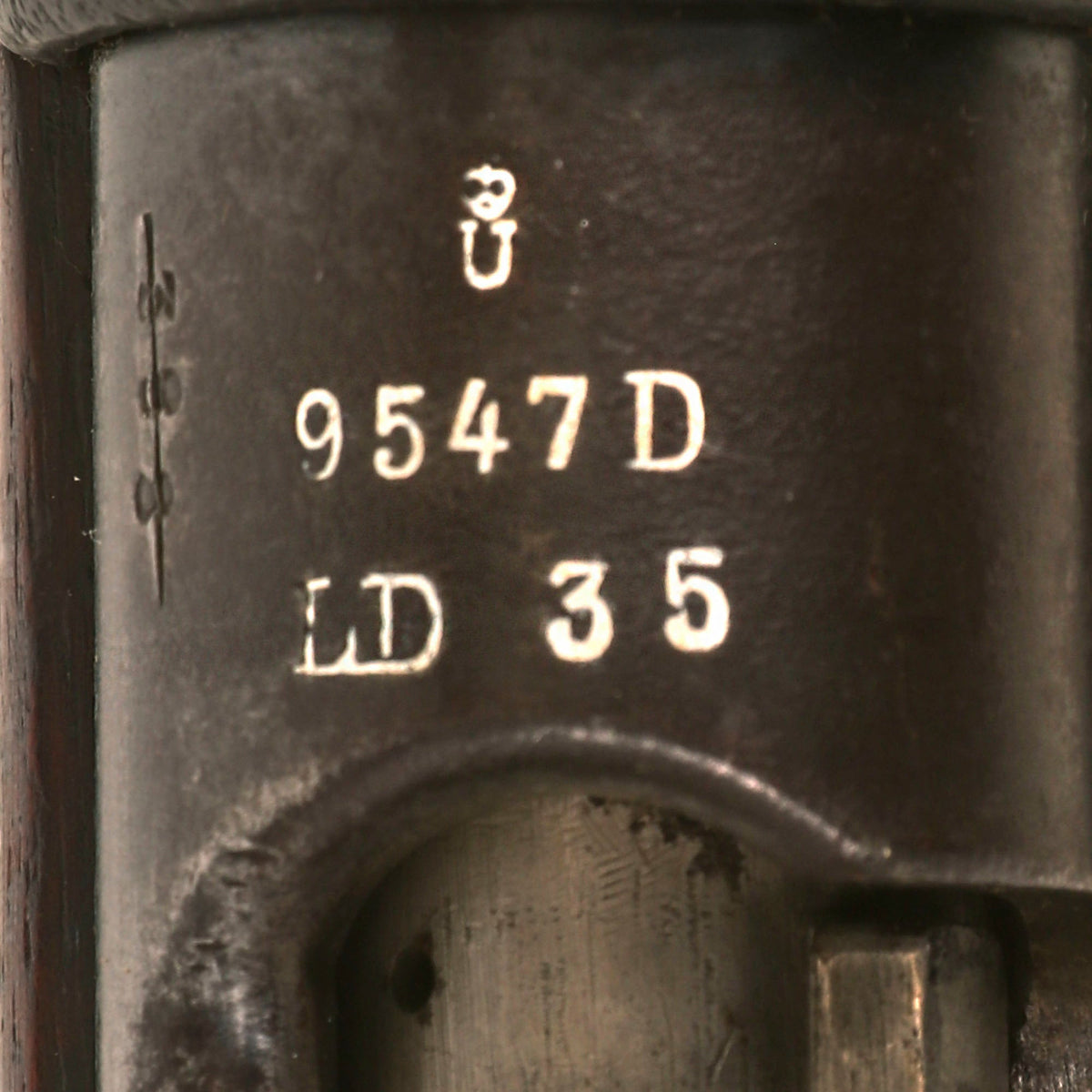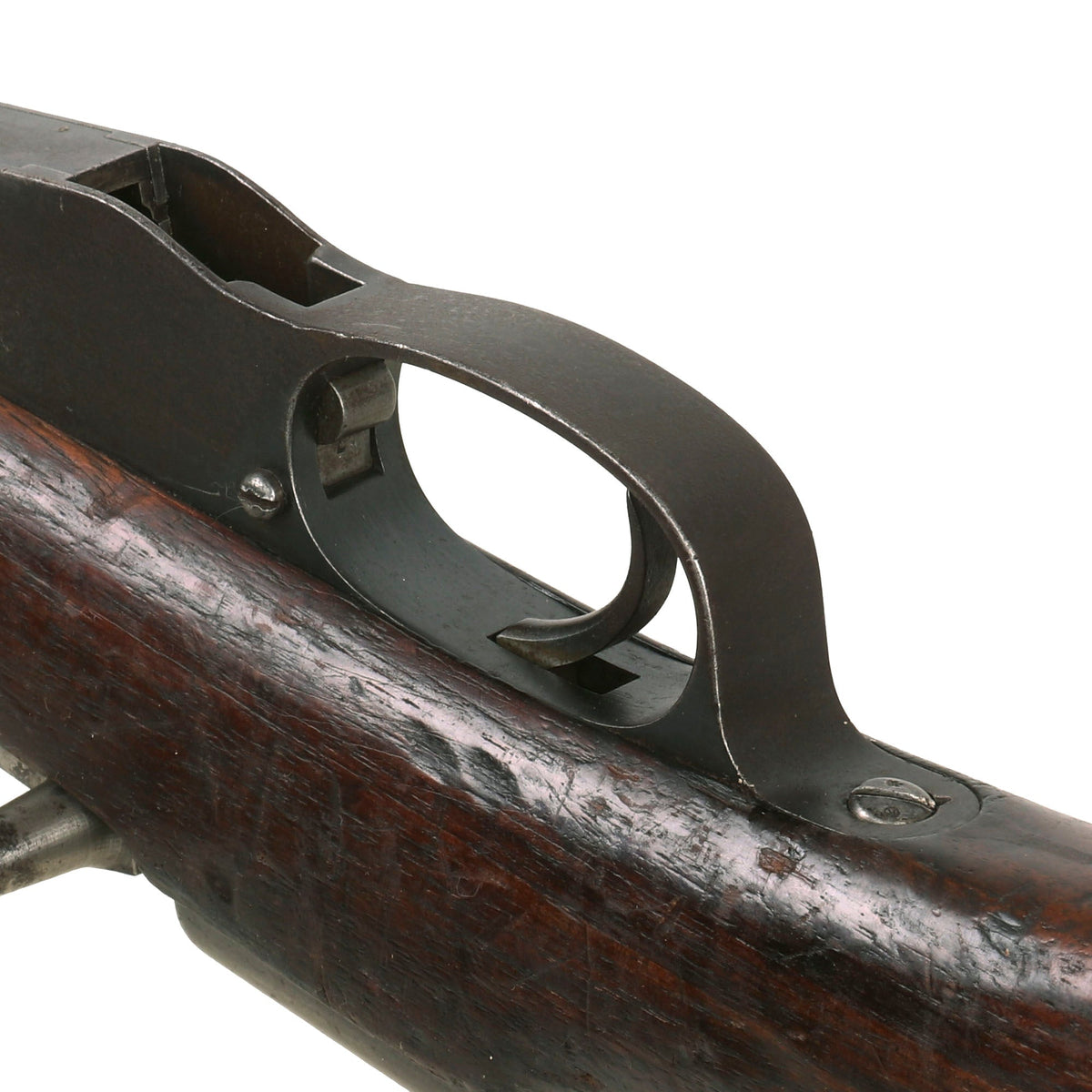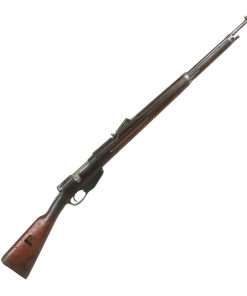Original Dutch Pre-WWI Geweer M. 95 Mannlicher KNIL Rifle by ŒWG Steyr Serial 9547D – Dated 1896 Original Items
$ 1.295,00 $ 323,75
Original Item: Only one Available. This is a very nice example of the Dutch Geweer M.95 Mannlicher Infantry Service rifle, which was the standard Dutch long rifle from 1895 and through WWI. It was still in service in some areas until at least 1955, especially by the Royal Netherlands East Indies Army (Koninklijk Nederlands Indisch Leger or KNIL). This example does not show an extreme amount of wear, though it definitely saw long service, possibly in the East Indies.
This rifle was manufactured by the Steyr Mannlicher firearms division of Österreichische Waffenfabriksgesellschaft (ŒWG, Austrian Arms-Manufacturing Company) in Austria. The right side of the receiver is marked STEYR 1896, and to the left is crossed out number 388. The right side of the butt stock also has a fully intact STEYR 1896 cartouche, which surrounds a CROWN / W marking, for Queen Wilhelmina of the Netherlands, who reigned 23 November 1890 – 4 September 1948.
Over the chamber it is marked with serial number 9547D, which is also marked on the barrel next to the receiver, under the top handguard. The number 47 is marked on the rear sight base, magazine housing, bolt release, nose cap, and elsewhere. The bolt is however non-matching, probably swapped at arsenal long ago, and other small components are non-matching a well. Under the serial number marking we also noted a stamped LD 35, which matches the LD / 35 circular cartouche on the left side of the butt stock, and the marking on the butt plate. We assume this is some type of regimental number. Definitely some great markings on this rifle, well worth further research!
Rifle is in very good used condition, and is solid overall. The metalwork has a worn blued patina, with some light peppering from decades of service and storage. The stock does not have any major damage, though it has had an interesting alteration: the addition of a Mauser K98k style slot through the butt stock, as well as having the front swing swivel moved to the side. There also is a threaded hole on the right side of the stock next to the slot, so we think maybe it was modified in the past to take a sling like those used on the Swedish Mauser Carbines. The original location for the butt stock sling swivel base was filled with a wood graft, so this was definitely an arsenal level modification. Otherwise the stock is in lovely shape, with some great markings with research potential
The rifle cycles and dry fires correctly, though we have no way to know whether the magazine will still feed. The bolt still retains an intact firing pin and extractor, and the safety is fully functional as well. The bore shows strong lands and grooves, though it does have fouling in the grooves and is overall a bit dark.
A very nice Dutch service rifle that possibly saw long service in the Dutch Colonies or elsewhere! Ready to research and display!
Specifications:-
Year of Manufacture: 1896
Caliber: 6.5×53mmR
Cartridge Type: Centerfire Cartridge
Barrel Length: 31 Inches
Overall Length: 50 3/4 Inches
Action type: Bolt-Action
Feed System: 5 round internal magazine with En-Bloc clip
History of the Dutch Mannlicher
The Geweer M. 95, also known to collectors as the Dutch Mannlicher, was the service rifle of the Armed forces of the Netherlands between 1895 and 1940 which replaced the obsolete Beaumont-Vitali M1871/88. At first it was produced by Steyr for the Dutch, but after 1904, production took place under license at Hembrug Zaandam in the Netherlands. Although often regarded as being based on the earlier Mannlicher 1893 Model, the rifle is in fact a modification of the Mannlicher rifle by August Schriever and the Dutch rifle commission[2]. The Dutch issued about 470,000 M.95s.
Both Dutch and Romanian rifles fired the same rimmed cartridge often referred to as “Romanian” 6.5×53.5mmR or “Dutch 6.5” 6.5×53 mmR. In military service, Dutch M.95 rifles (6.5×53 mmR) cartridges are loaded primarily through the use of an en-bloc clip, similar in concept to the clip used later by the US Army’s M1 Garand. With the Ferdinand Mannlicher designed trigger guard / magazine housing assembly, when the bolt is open and fully retracted to the rear the full en-bloc clip is loaded into the magazine from the top through the open receiver. The empty clip will fall out through a hole in the base of the magazine housing when out of cartridges. This enabled quick reloading of the rifles during combat. When the bolt is in the fully open and retracted position, full clips can be vigorously ejected upwards from the magazine housing by means of a spring loaded latch at the rear of the magazine. This is operated by a recessed button in the front of the trigger guard portion of the assembly. The clips were essentially disposable as ammunition would be issued already loaded into clips from the factory.
Fast Shipping with Professional Packaging
Thanks to our longstanding association with UPS FedEx DHL, and other major international carriers, we are able to provide a range of shipping options. Our warehouse staff is expertly trained and will wrap your products according to our exact and precise specifications. Prior to shipping, your goods will be thoroughly examined and securely secured. We ship to thousands clients each day across multiple countries. This shows how we're dedicated to be the largest retailer on the internet. Warehouses and distribution centres can be located throughout Europe as well as the USA.
Note: Orders with more than one item will be assigned a processing date depending on the item.
Before shipping before shipping, we'll conduct a thorough inspection of the items you have ordered. Today, the majority of orders will be delivered within 48 hours. The delivery time will be between 3-7 days.
Returns
The stock is dynamic and we cannot completely manage it because multiple stakeholders are involved, including our factory and warehouse. So the actual stock may alter at any time. It's possible that you may not receive your order once the order has been made.
Our policy is valid for a period of 30 days. If you don't receive the product within 30 days, we are not able to issue a refund or an exchange.
You can only return an item if it is unused and in the same state as the day you received it. You must have the item in its original packaging.
Related products
Uncategorized
Uncategorized
Uncategorized
Uncategorized
Uncategorized
Uncategorized
Armoured Fighting Vehicles of the World: AFVs of World War One (Hardcover Book) New Made Items
Uncategorized
Uncategorized
Uncategorized
Uncategorized
Uncategorized
Uncategorized
Uncategorized
Uncategorized
Armored Burgonet Helmet & Polearm from Scottish Castle Leith Hall Circa 1700 Original Items
